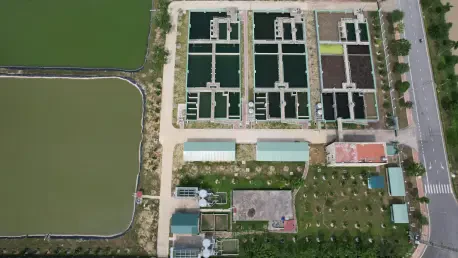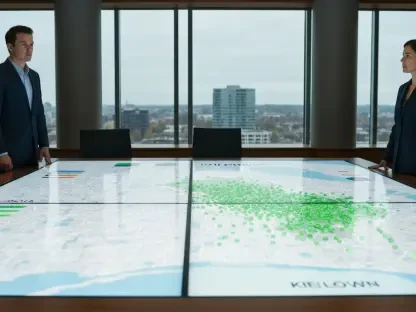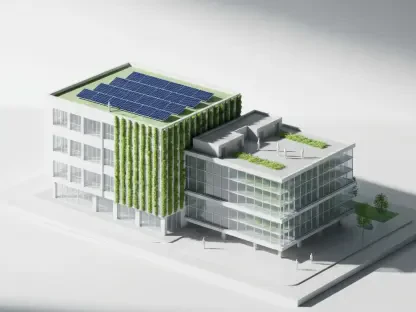In Wiltshire, the recent influx of diverse planning applications presents an intriguing glimpse into the county’s developmental aspirations. These submissions to the local council reflect a broad spectrum of initiatives ranging from agricultural advancements and residential expansions to commercial updates and community enhancements. The central challenge lies in harmonizing these varied goals to promote sustainable urban-rural growth. Behind these applications is an underlying narrative that strives to balance modernization needs, infrastructure improvement, and ecological stewardship while still honoring Wiltshire’s pastoral heritage.
Agricultural Advancements and Rural Sustainability
Embracing Infrastructure to Boost Agricultural Productivity
The Wiltshire region is witnessing a tangible shift in agricultural planning, as seen in several applications focusing on enhancing rural infrastructure. At New Barn Farm in Easton Grey, Malmesbury, a proposed agricultural worker’s dwelling symbolizes the commitment to affirming the vitality of farming communities. Meanwhile, the planned steel-framed barn at Willow House in Great Hinton signifies an intent to improve livestock management through better structural facilities. Beyond individual sites, the proposed transition from equestrian to agricultural land near Bromham indicates regional support for revitalizing farming capabilities, shedding light on an overarching emphasis on agricultural productivity and sustainability.
These developments resonate beyond their immediate locales by suggesting an essential adaptation to changing agricultural demands. In practical terms, this means providing adequate housing for workers and modern barns suitable for enhanced livestock care. The ambitions embodied in these proposals also underscore a return to traditional agricultural roots, yet with a forward-looking approach that embraces modern technology and practices. This could translate into healthier livestock, more efficient crop production, and enhanced ecological resilience, addressing both economic viability and environmental concerns that define sustainable rural landscapes.
Fostering Community Engagement in Agricultural Growth
The enhancement of agricultural infrastructure in Wiltshire extends to broader community engagement, linking rural growth with its socio-economic fabric. Proposed projects like the change from equestrian use to agricultural fields near Bromham also emphasize this alignment. These changes reflect an intensified focus on maximizing land use for agriculture, potentially augmenting regional food production capabilities and economic performance. The collaboration between local authorities, residents, and developers can catalyze sustainable growth by aligning agricultural initiatives with community needs and environmental protection.
Developers are encouraged to engage stakeholders in these projects to ensure alignment with local priorities and ecological considerations. By involving community voices, from farmers to local councils, developers can harness a collaborative spirit that fosters innovation and resilience. This cooperative ethos is key to crafting agricultural solutions that are both effective and acceptable to local residents, ultimately maintaining Wiltshire’s cherished rural identity. In doing so, stakeholders can balance economic, ecological, and social imperatives while nurturing a vibrant rural economy that sustainably supports its population.
Residential Enhancements and Urban Living Spaces
Expanding and Modernizing Living Environments
The residential planning applications in Wiltshire suggest a keen interest in expanding and upgrading living spaces to meet evolving lifestyle demands. Proposals such as the utility extension at Armyn Cross Farm in Minety, Malmesbury, and renovations at 15 High Street in Great Cheverell, Devizes, reveal a trend towards improving the functionality and aesthetics of existing properties. This impetus for change is further exemplified in plans for single-story extensions in more suburban locales like St. Georges Place in Semington, as well as ambitious projects like two-story side extensions and loft conversions in Westbury.
What emerges from this pattern is not merely an appetite for larger homes but a wider desire to adapt aging residential stock to meet contemporary needs. Whether through expanding kitchens, adding bedrooms, or modifying living areas for multi-generational families, these projects illustrate an enduring commitment to enhancing home environments. This trend signals a crucial adaptation to population dynamics, building regulations, and personal preferences, focusing on improving utility, comfort, and sustainability within urban centers. This reflects a broader societal transition towards more personalized, functional living spaces.
Navigating Design Challenges and Community Integration
While the desire to improve home environments in Wiltshire is evident, considering neighborhood integration and architectural harmony remains a pertinent challenge. These developments must not only conform to planning regulations but also respect the aesthetic coherence and cultural heritage of local areas. Homeowners and builders must navigate architectural constraints when extending or renovating residences to ensure changes enhance rather than detract from community character.
To mitigate these hurdles, effective planning and consultation with local authorities and heritage groups are vital. Collaborative discussions can ensure that improvements balance individual aspirations with collective values, optimizing the integration of modern conveniences with traditional styles. In addressing these challenges, the opportunity arises to innovate in home design, incorporating sustainable materials and technologies that reflect Wiltshire’s commitment to ecological resilience. This approach helps strike a balance between modernization and community cohesion, paving the way for a future that values neighborhood identity integrity alongside contemporary functionality.
Commercial Innovations and Modern Business Infrastructure
Revitalizing Business Premises for Contemporary Needs
Commercial planning applications in Wiltshire portray an ambitious effort to revamp business establishments to align with current operational requirements and consumer expectations. With applications for updates such as new signage at 32 The Market Place in Devizes and the introduction of solar panels at Lea & Garsdon C of E Primary School, these developments aim to transform the landscape of local commerce. Additionally, proposals for alterations at Buildbase Ltd in Calne, including the erection of new structures, demonstrate an acute awareness of the need to enhance operational efficiency and modernization within business facilities.
Modernizing commercial spaces is not just about aesthetic enhancements but also about incorporating cutting-edge technology to improve business processes. By integrating sustainable energy solutions like solar and energy-efficient infrastructures, businesses in Wiltshire are adapting to regulatory pressures and societal demands for eco-conscious practices. These applications are a testament to a forward-thinking ethos among local enterprises, reflecting a broader shift towards sustainability that delivers tangible benefits, from cost reductions in utility expenses to improved environmental credentials.
Aligning Commercial Growth with Community Values
While advancing business capabilities remains a priority, aligning commercial growth with community values is equally crucial in ensuring the harmonious evolution of Wiltshire’s business landscape. Developments that contemplate community engagement and social responsibility will likely see the greatest acceptance and success. Businesses can help foster this harmony by actively promoting green technologies, supporting local employment, and participating in community initiatives that yield mutual benefits.
The successful implementation of these commercial enhancements hinges on robust stakeholder collaboration. By ensuring that business practices and developments resonate with local values and priorities, enterprises can better connect with consumers and local communities. Establishing transparent communication channels with local authorities and stakeholders can also facilitate these objectives. This alignment of commercial pursuits with community-centric strategies fosters greater inclusivity and ensures that modernization efforts contribute to a dynamic, supportive marketplace that thrives on mutual benefit and social cohesion.
Technological Integration and Green Initiatives
Promoting Sustainable Technologies and Renewable Energy
A pronounced trend in the recent planning applications in Wiltshire is the emphasis on integrating sustainable technologies and renewable energy solutions. The installation of solar panels at locations like Rockfield House in Colerne or Newtown Farm House in Shalbourne reflects a growing commitment to reducing carbon footprints and embracing eco-friendly solutions. In addition to solar energy, proposals for air source heat pumps and electric vehicle charging points underscore the region’s dedication to transitioning to cleaner, more sustainable energy sources.
Adopting sustainable technologies is critical in advancing local goals towards reduced emissions and energy independence. By investing in renewable infrastructure, residents, businesses, and local authorities can collaboratively contribute to environmental stewardship. These initiatives are not only environmentally responsible but also financially advantageous, offering opportunities for reduced energy costs and enhancing property values. They indicate a future where renewable energy integration becomes a cornerstone of regional development, reinforcing Wiltshire’s role as a proactive leader in tackling climate challenges.
Waste Management and Innovative Environmental Practices
In tandem with renewable energy integration, innovative waste management solutions are emerging as vital components of sustainable development in Wiltshire. Applications like the Revamp Your Tank Scheme at Snowdrop Cottage in Pewsey highlight an evolving narrative that prioritizes efficient waste disposal and resource management. By advancing these initiatives, Wiltshire seeks to remedy ecological concerns, improve water quality, and promote recycling and resource recovery.
Innovative environmental practices transform how communities interact with waste, reducing reliance on landfills and enhancing circular economy principles. Through education and community collaboration, Wiltshire could leverage these initiatives to foster environmentally sound behaviors and cultivate community-wide engagement in sustainable practices. The deployment of cutting-edge waste management systems symbolizes the intersection of technology and community-driven goals, wherein each effort supports a clean, sustainable future characterized by the responsible management of natural resources.
Community Enhancements and Infrastructure Development
Bolstering Community Facilities and Accessibility
In addition to agricultural, residential, and commercial developments, a significant portion of the applications highlights the improvement of community facilities and infrastructure. Noteworthy projects like rebuilding Christian Malford Village Hall and tackling flooding issues at Bowerhill Village Hall articulate an unyielding commitment to nurturing community spaces. Additionally, redevelopment proposals at Whitley Golf Course show an interest in maintaining and rejuvenating public recreational areas.
These community-centered undertakings emphasize reinforcing social cohesion and accessibility in Wiltshire. By improving halls, recreational venues, and other community spaces, officials and residents are delineating priorities that bolster local interactions and cultural gatherings. Infrastructure improvements not only cater to current community needs but also serve as a hub for enrichment activities, fostering connections and fortifying social ties. Such dedication to enhancing public spaces illustrates a profound recognition of community as the bedrock of regional growth, where accessibility and inclusivity stand at the forefront of local planning.
Harmonizing Development with Cultural Heritage
While improving infrastructure is vital for community enrichment, ensuring that developments harmonize with Wiltshire’s cultural heritage remains imperative. Projects must be approached with sensitivity to historical contexts and traditions, warranting that any new construction or renovation honors the region’s legacy yet facilitates modern utility. Achieving this balance requires a nuanced approach sensitive to both conservation and progress, ensuring that modern advancements do not come at the expense of historical integrity.
Stakeholders, including local authorities, planners, residents, and historians, are encouraged to collaborate in nurturing this integration. Drawing from extensive consultations, they can create a balanced blueprint that respects traditional architectures while embracing innovative designs. Through this cooperative focus, development projects could capture the spirit of Wiltshire while propelling it forward, with each step embodying the harmony between durable growth and cultural appreciation. By honoring past and present simultaneously, Wiltshire evolved into a thriving environment where progress and tradition coexist seamlessly.
Strategic Pathways to Reflective Development
Wiltshire is witnessing a fascinating surge in planning applications that showcase the area’s developmental ambitions. These proposals submitted to the local council reflect a diverse array of initiatives aimed at transforming the landscape and community. The projects range from advancements in agriculture, expansion of residential spaces, updates to commercial properties, and various enhancements designed to benefit the community as a whole. The primary challenge is to integrate these varied objectives in a way that supports sustainable growth while bridging the gap between urban and rural environments. At the heart of these applications is a compelling story of balance—one that aims to weave together modernization, infrastructure improvements, and ecological responsibility. All of this is carried out with a deep respect for Wiltshire’s traditional pastoral charm. The county must navigate the complexities of progress while ensuring that the development is sympathetic to its heritage and environment. By managing these applications wisely, Wiltshire aspires to evolve in a way that respects both its rich history and future potential. This ongoing process will shape a county that thrives with modern amenities while embracing its cultural roots.









